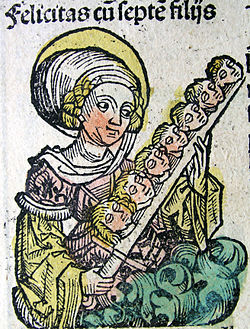Felicitas of Rome
| Saint Felicitas of Rome Saint Felicity of Rome |
|
|---|---|

Image of St Felicitas and her seven sons. From the Nuremberg Chronicle (1493).
|
|
| Martyr | |
| Born | c. 101 Rome, Roman Empire |
| Died | c. 165 Rome, Roman Empire |
| Venerated in |
Roman Catholic Church Eastern Orthodox Church |
| Canonized | Pre-Congregation |
| Major shrine | Church of Santa Susanna, Rome |
| Feast | 23 November |
| Attributes | woman in widow's weeds holding a palm; woman with a palm, book, and children at her feet; woman with Saint Andrew the Apostle; woman with seven sons |
| Patronage | parents who have lost a child in death; death of children; martyrs; sterility; to have male children; widows; (reflecting only St Martialis) - Town of Torricella Peligna, Province of Chieti,Town of Collarmele, Province of Aquila, in the Abruzzo, The City of Stevenage in Hertfordshire, UK and the town of Isca sullo Ionio, Province of Catanzaro, Calabria, Italy |
Felicitas of Rome (c. 101 – 165), also anglicized as Felicity, is a saint numbered among the Christian martyrs. Apart from her name, the only thing known for certain about this martyr is that she was buried in the Cemetery of Maximus, on the Via Salaria on a 23 November. However, a legend presents her as the mother of the seven martyrs whose feast is celebrated on 10 July. The Eastern Orthodox Church celebrates their martyrdom on 25 January.
The legend of Saint Symphorosa is very similar and their acts may have been confused. They may even be the same person. This Felicitas is not the same as the North African Felicitas who was martyred with Perpetua.
The feast of Saint Felicitas of Rome is first mentioned in the "Martyrologium Hieronymianum" as celebrated on 25 January. From a very early date her feast as a martyr was solemnly celebrated in the Roman Church on that date, as shown by the fact that on that day Saint Gregory the Great delivered a homily in the Basilica that rose above her tomb. Her body then rested in the catacomb of Maximus on the Via Salaria; in that cemetery all Roman itineraries, or guides to the burial-places of martyrs, locate her burial-place, specifying that her tomb was in a church above this catacomb. The crypt where St Felicitas was laid to rest was later enlarged into a subterranean chapel, and was rediscovered in 1885.
In the early Middle Ages there was a chapel in honour of St Felicitas in an ancient Roman edifice near the ruins of the Baths of Titus.
Some of her relics are in the Capuchin church at Montefiascone, Tuscany. Others are in the church of Santa Susanna in Rome.
...
Wikipedia
